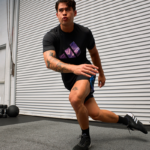
One of the architects of the modelling behind Australia’s path out of lockdown says New South Wales’ Covid case numbers are too high for widespread vaccinations to contain the virus as envisioned in the plan.
University of Melbourne professor of mathematical biology James McCaw said if NSW case numbers weren’t reduced, “stronger social measures and stronger versions of lockdowns rather than weaker” would be needed even once vaccination rates reached 70%.
Doherty Institute modelling, released earlier this month, underpins the federal government’s four-phase roadmap out of Covid lockdowns which suggests that once 70% of people older than 16 are vaccinated, the need for “stringent lockdowns” would be “unlikely” in Australia.
The modelling has been referenced by the NSW government during the state’s worsening Delta outbreak, with the premier, Gladys Berejiklian, suggesting some restrictions would be wound back once vaccination targets were met.
As daily cases rose above 600 this week, Berejiklian said the state was “learning to live” with the Delta variant and warned other states would need to accept that “when you get to a certain level of vaccination and open up, Delta will creep in”.
“We can’t pretend that we will have zero cases around Australia with Delta. As the Doherty report says, once you get to 80% double dose and you have to open up, everyone will have to learn to live with Delta,” she said.
Sign up to receive the top stories from Guardian Australia every morning
But while the Doherty modelling outlines a path to fewer restrictions after national vaccinations hit 70%, it also assumes outbreaks beginning in the 10s rather than hundreds, “continuous low-level social restrictions” and an “optimal” testing, tracing, isolating and quarantine system to control numbers.
McCaw, who holds an honorary position at the Doherty Institute, said on Friday that NSW was “clearly” not in that situation.
“It is absolutely the case, if we want to manage the spread of virus once we have high vaccine coverage, we need those test, trace, isolation and quarantine measures to be working effectively, and at high caseloads the public health units are under a lot of stress and obviously those things are not working optimally,” he said.
“They are just not as effective [and so] obviously it’s harder to control the spread of the virus, so something else has to help and what that other thing is, is stronger social measures and stronger versions of lockdowns rather than weaker.
“Therefore NSW needs to work to continue to reduce those case numbers and get the outbreak under control. There is a very, very clear and coherent relationship between the targets Doherty puts forward and the response required by NSW to help us get there.”
The Doherty modelling suggests that once the vaccination coverage reaches 70% and then 80% the rate of severe infections is reduced, but under an “uncontrolled outbreak” scenario, between 1,300 and 2,000 people would still die from 10,000 to 20,000 severe infections within six months. If testing and tracing systems are only partially effective, the rate of deaths could be more than 100 times worse.
On Friday, the NSW government announced a suite of harsher restrictions for local government areas in western Sydney that have become the epicentre of the city’s outbreak. They include curfews, outdoor mask mandates and a one-hour limit for daily exercise.
According to University of Melbourne epidemiologist Prof Tony Blakely, even those measures may not be enough to push the city’s Covid cases back down to single digits.
Quick Guide
How to get the latest news from Guardian Australia
Show

Separate and yet-to-be-published modelling by Blakely and his team looked at a series of different lockdown and vaccination scenarios in an attempt to map how long NSW would take to reach fewer than five cases a day.
Starting from the beginning of August, it found that even harder lockdown measures such as those applied in Victoria during its long 2020 lockdown would likely not bring cases down to single digits before the state reached a 70% vaccination rate.
“Those measures like the outdoor mask mandate might help plateau the numbers, I’m hopeful, I can’t say optimistic, but hopeful that it at least stops the increases in the numbers,” he said.
“It’s going to take some time to get to five cases per day – if that’s even achievable. It would take a long time and I’m not sure whether either the NSW citizens or politicians have the appetite to stay in lockdown for that long.”


